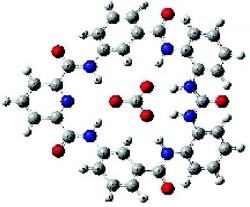
A group of scientists working on synthesising new anion receptors have accidently stumbled on a bowl shaped molecule that suggests new techniques for dealing with atmospheric CO2, writes Sarah Day.
Geoscientist Online, 17 July 2009
In the search for novel approaches to dealing with global warming, 'advances may occur fortuitously', according to University of Maryland's Professor John Tossell. In his case, the good fortune lay not in leaving plates on a lab bench to go moudly, but in the abilities of a colleague to recognise the importance of a chance discovery.
Whilst carrying out experiments designed to synthesize new anion receptors for use in biological transport systems, Professor Jeffery Davies, also of the University of Maryland, noticed an interesting outcome.
One of the experiments had yielded a complex with a CO3 group trapped in the middle of a ‘bowl shaped cavity’. The source of the CO3 appeared to be the atmosphere in the laboratory, and the ease with which it was formed suggests that the bowl shaped molecule is highly stable, making it a potentially useful tool in absorbing atmospheric CO2.
Professor Tossell cautions that the molecule itself ‘may be too difficult to synthesize to be used economically to capture CO2'. However, he remains enthusiastic about the potential applications of the discovery, which suggests new areas of investigation in the search for materials to capture CO2 from power plants, flue gases or directly from the atmosphere.
‘Principles may emerge…which will lead to a deeper understanding of how to design cheaper amide derived CO2 receptors’, he says.
One such suggestion is the possibility of developing ‘living organisms’, which could contain such ion receptors within their cell membranes and be used as CO2 ‘catchers’.
The discovery is to be published in the August 3 issue of the American Chemical Society’s bi-weekly journal, Inorganic Chemistry.